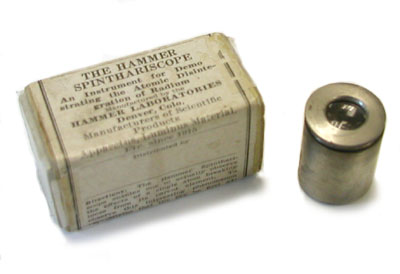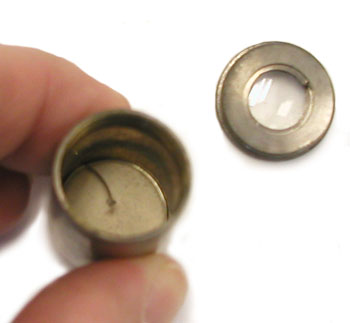The Hammer Spinthariscope (ca. 1940s)


The spinthariscope featured here was sold by Hammer Laboratories of Denver, Colorado, sometime in the 1940s.
Described as "an instrument for demonstrating the atomic disintegration of radium," it employs the standard design wherein the radium source is attached to the tip of a wire/needle positioned just above a zinc sulfide screen (see photo above right).
It’s certainly well-made—the body is nickel-plated brass and the lens is glass.
Size: 1" x 0.75"
The catalog number for the Hammer Laboratories spinthariscope (No. 3,299) was a joke. It’s the only catalog item with a number in the 3,000s, and the closest catalog number to it, 2,544 (carnotite ore samples), is the only number in the 2,000s.
Two versions were available. The more expensive ($4.00) of the two was 0.75” in diameter, while the cheaper ($2.00) was 0.5" in diameter. The latter, it was noted, was more convenient for carrying in the pocket.
Quoting the label on the box:
"The Hammer Spinthariscope enables one to actually observe the effects of a single atom breaking loose from its parent element. To observe this interesting phenomenon necessitates that the eye be first adjusted, i.e., that the pupil be dilated by remaining in a darkened room 10 to 15 minutes. At night it is naturally adjusted.
The radium, placed on the underside of the wire projector in the bottom of the instrument, disintegrates expelling atoms of helium (alpha rays) with a velocity of 12,500 miles per second. These atoms strike the phosphorescent zinc sulphide applied in the bottom producing brilliant flashes of light which are observed through the adjustable high power lens at the top. One milligram of radium, 1/28,000 of an oz., would produce for hundreds of years about 148,000,000 scintillations per second.
For an hour or more before using, the Hammer Spinthariscope should be kept away from direct light since such light causes the phosphorescent material to become self-luminous, making it impossible to distinguish the scintillations caused by radium.”
Raymond Franklin Hammer
Raymond Franklin Hammer was born in Princeville, Illinois on April 16, 1882. He graduated from the University of Illinois in 1910 with a degree in chemistry. For a short period, Hammer worked with the Lakeshore and Michigan Southern Railway Company in Cleveland (ca. 1910-1911), but the position didn’t suit him and he moved to Denver in 1911. Perhaps he thought that Denver was a good place for a chemist to gain experience in the radium business. Shortly after arriving in Denver (ca. 1913-1914), he served as the acting curator in the Geology Department at the Colorado Museum of Natural History and helped organize an exhibit regarding radium-bearing minerals. It might have been in 1915, or possibly a little later, that he founded the Hammer Radium Company. In 1920 he married Esther Eppinger in Denver (Daily Illini, 12 March 1920).
In the early 1930s, he changed the name of his company to Hammer Laboratories and moved to Chicago. But he only stayed in Illinois for a few years before moving back to Denver. In 1942, despite being 60 years old, he was required to complete a draft registration card. The government official involved noted on the card that Hammer had a scared right middle finger, something that might have resulted from handling radium sources.
In1950 he moved to southern California where he seems to have turned off the lights of Hammer Laboratories. No more Colorado winters. Raymond Hammer passed away on the fourth of July, 1959 in San Diego.
Hammer Radium Company
In Catalog No. 8, Hammer claimed that his company had been “manufacturers of scientific products since 1915.” This seems plausible, although the earliest reference I have for to the Hammer Radium Company is the 1918 Colorado Business Directory.
As the company’s name implied, their products contained radium. The following is at least a partial listing:
Pieces of radium ore
Radium Ore Bar
Hammer Standard Radium Pads
Radiumar Cosmetics
Radiumar Ointment
Bathettes
Radium-Antitox
Hammer Antiseptic Radium Suppositories
Hammer Laboratories
Radium Water Activator
The Hammer Radium Company Activator was used as the source of radium emanation (radon) in the Radium Water jars sold by Radium Health Products of Canada.
Hammer Radium Company addresses:
1840 California Street, room 13, Denver CO (1918-1922)
1405 Glenarm Place, rooms 201 and 208, Denver, Colorado (1924-1926)
209 16th Street, Majestic Building, room 435, Denver, Colorado (1931)
Hammer Laboratories
By late 1930, things had changed. Newspaper advertisements began referring to Hammer Laboratories and the products being advertised were not radioactive. Apparently Raymond Hammer’s intent was to eliminate radium from the company’s products as well as its name.
The following transcription is of the text in a pair of newspaper advertisements from October and November of 1930 (Carrizozo Lincoln County News).
Try Salciphene First. Quick Relief for Eczema/Burns. 50 cents at your Druggist or write Hammer Laboratories - Denver.
No mention of radium there.
This transition from the Hammer Radium Company to Hammer Laboratories might have been a pre-emptive response to an impending Federal Trade Commission (FTC) investigation.
Nevertheless, Hammer Laboratories seems to have continued selling radium-containing products for a year or two. In fact, the company’s listing in the 1931 Denver City Directory specifically stated that it sold radium energizer water jars, ointment, and ores. More to the point, the FTC’s investigation attributed the sale of a long list of radioactive products to Hammer Laboratories. Perhaps Hammer was selling off his old radioactive stock as part of the switch to a new product line described in the 1932 Colorado Business Directory as “cosmetics.”
The FTC complaint, filed in May of 1932, charged Hammer Laboratories with “Advertising falsely or misleadingly as to results or qualities... of various purported radium products.” However, on February 17, 1934 the case was dismissed “for the reason that "the respondent corporation [Hammer Laboratories] has been dissolved."”
But Hammer Laboratories didn’t dissolve. What Hammer did was move back to Illinois. Later that year (i.e., 1934), a newspaper advertisement indicated that Hammer Laboratories was located in Chicago (Southtown Economist. Nov. 22 1934):
“CORNS ENDED PAINLESSLY. Rapid Relief for All Corns “Corn Popper” relieves pain immediately. Even longest standing corns quickly eliminated. Guaranteed treatment. At your druggist or mail 25 cents. Hammer Laboratories 3103 South Halstead Street, Chicago.”
I don’t know exactly when Raymond and Esther returned to Denver, but the 1940 census indicated that he was working there as a “manufacturing chemist.”
By the 1940s, Hammer Laboratories was out of the cosmetics business. They were now selling laboratory supplies of the sort used for classroom demonstrations or experiments at home: spinthariscopes, scintillascopes, electroscopes, spectroscopes, pocket magnifiers, magnets, arc lamps, UV lamps, color filters, fluorescent paints, phosphorescent screens, radioactive luminous material, luminous tubes, radioactive sources, radioactive ore, and radium extraction demonstration sets.
And their marketing campaign had gone nationwide! Classified ads for Hammer Laboratories began appearing in Popular Mechanics in 1943. Luminous paint must have been the company’s big seller because they were featured in every ad. The last of the Popular Mechanics advertisements seems to have appeared in the January 1950 issue. Aside from being the last advertisement, it was also the first to provide a San Diego address. Maybe Hammer decided that it was time to retire and enjoy life in southern California.
Hammer Laboratories addresses:
1108 15th Street, Central Savings Bank Building, room 625, Denver, Colorado (1931, 1932)
1108 15th Street, Central Savings Bank Building, room 607, Denver, Colorado (1933)
3103 South Halstead, Chicago, Illinois (1934)
624 Monaco Boulevard, Denver 7, Colorado (1943-1948)
4034 University, San Diego, California (1950)
Hammer's Probable Interaction with the Denver Radium Service and the Home Products Company
Raymond Hammer almost certainly had some sort of business interaction with the Denver Radium Service and the Home Products Company. Both of these sold radium containing products similar to those produced by the Hammer Radium Company, but neither of them possessed any real expertise when it came to chemistry of radium. Raymond Hammer had that expertise—he was a trained chemist.
The companies’ addresses provide good circumstantial evidence for such an interaction. Let’s consider the Denver Radium Service first.
From 1924 to 1926, the Hammer Radium Company occupied rooms 201 and 208 at 1405 Glenarm Place in Denver. Was it just a coincidence that the Denver Radium Service was located at 1405 Glenarm Place in 1928? A little later, from 1931 to 1932, Hammer Laboratories moved into room 435 of Denver’s Majestic Building. This is obviously a case of lightning striking twice because the Denver Radium Service occupied rooms 401, 428 and 438 in the Majestic Building at various times between 1930 and 1948! Sally Bryan, who ran the Denver Radium Service, stated in her company’s literature that she was assisted by some “well known” chemists. Sounds like Raymond F. Hammer to me.
With regard to the Home Products Company, they and their predecessors (Vital-O-Remedy Company, Vital-O-Gland Company) occupied Denver’s Evans Building on the southwest corner of 15th Street and Lawrence Street from 1919 to 1931. This was on the same block as the Central Savings Bank Building where the Hammer Laboratories were located from 1931 to 1933. In fact, one of the two men responsible for The Home Products Company would go to work at the bank. Neither he nor his partner, Eugene Gurley, were chemists, nor did they have any obvious connection to the radium business. Nevertheless, they sold radium-containing products, some very similar to those of the Hammer Radium Company, e.g., radium suppositories. They had to get the radium from somebody, and that somebody was probably Raymond Hammer.
Timeline
|
1882
|
Raymond Franklin Hammer is born in Princeville. |
|
1910
|
Hammer graduates from the University of Illinois with a chemistry degree. |
|
1911
|
Hammer moves to Denver. |
|
1914
|
He is Acting Curator in the Geology Department at the Denver Museum of Nature and Science. |
|
1918-1930
|
He is running the Hammer Radium Company in Denver. |
|
ca. 1930
|
The company name changes to Hammer Laboratories. |
|
1934
|
Hammer Laboratories moves to Chicago. |
|
1940
|
Hammer is back in Denver. |
|
1950
|
Hammer Laboratories move to San Diego. |
|
1959
|
Raymond Franklin Hammer dies. |
References
- Federal Trade Commission. Decisions, Findings, Orders, and Stipulations. June 19, 1933 to April 23, 1934. Vol. 18.
- Hammer Laboratories Catalog No. 8. ca 1940s.
- Hanington, C. H. the Colorado Museum of Natural History - An Historical Sketch. Proc. Col. Museum Nat. History. Vol. 17 (1). Mar. 1, 1938.
- University of Illinois. Semi-annual Alumni Record. 1918.
